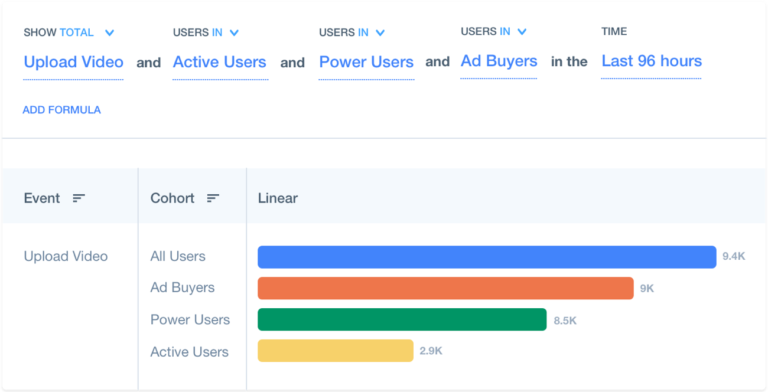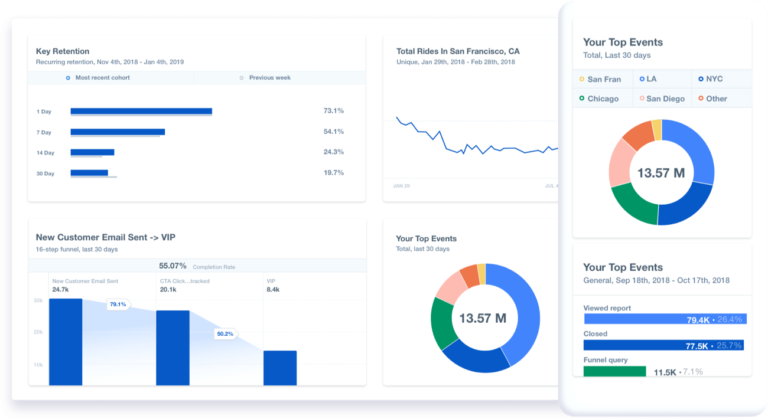The anatomy of user behavior
Understanding how people use your product begins with tracking their actions
It all starts with a single user taking a simple action: finding a video in a feed and tapping play, running a report in a business tool, navigating to the account view in a banking app to check the balance. These simple actions, or “events,” are the reasons people use a product. Tracking these actions is the foundation of the data-driven analytics that inform today’s digital products: the websites we visit, the tools we use, and the apps on our phones.
It didn’t used to be this way
When Mixpanel launched ten years ago, the idea of measuring a product by user events was novel. The web was only just making it through its awkward teenage years. And there were basically only two events that every site and every business used to measure their online offering: a pageview and a sale.
Today, when data-driven companies measure the success of their digital products, it all starts with that simple business-specific event. But it doesn’t end there. Those events make up the foundation of a sophisticated approach to understanding how people are using their product, and thus how to help customers get value out of that product.
A simple event
Tracking pageviews was simple but not all that insightful. User actions are a more detailed way of tracking, and one of the first steps in this sort of granular analysis is figuring out which behaviors are important.
Do you just track everything? Every single button and toggle and screen? There’s something comforting about knowing you’re getting it all. It means you’re not missing out on anything. But when it comes to making sense of everything, it also means you’re likely to be overwhelmed and probably unable to translate those events into insights that lead to actions that improve your product.
The behaviors you are going to want to track will depend on your product and how people are getting value from it.
For a product like YouTube, one important event is most likely going to be “video played.” But they’d also be interested in tracking actions like subscriptions, likes, comments – and for the creator side of the product – video uploaded.
For my bank, the event might be something as simple as “view balance” while also tracking all the other uses for that app, like scheduling a payment, looking up an ATM, or depositing a check.
And at Mixpanel, the high-level event that shows that people are getting value from our product and that makes up the foundation of our analytics is a “report run.”
That’s where you start. Track those actions and start sending the events. But for those events to eventually mean something to you, they’re going to need context. That’s where event properties come in.

The event-focused model begins with a log of events and their properties.
Event properties give context
Simply counting events can only tell you so much. It’s only when you begin breaking down actions into smaller segments like “video played” by country, gender, or operating system.
There are a few things that help to do this – things like a timestamp (to tell you when something happened) and user ID (to tell you who did it). With the timestamp you can group events by day and by week and by month and you see if something is increasing over time. User ID allows you to see how many unique people are performing a particular action.. A thousand people taking an action once is very different than a hundred people taking an action ten times each.
In the old pageview model, people looked at unique visitors. Today, in our event-focused model, the number of unique people taking a meaningful action is an indication of active users. This is an important metric for understanding the size of a product’s user base.
With each additional property, you have a new way to look at your event and your product.

Grouping events by users allows you to see where your product engagement is coming from.
Let’s say your “video played” event has a “category” property on it that shows what type of video it is, or the “ran report” event in your tool has a “report type” property. Now, when you’re analyzing how people are using your product you can understand the types of videos they’re watching or reports they’re running. Maybe the overall number of videos played is growing over time, but it’s all coming from the “comedy” category. Or maybe your users are obsessed with running the same report over and over again.
With each property you add on to your event, it becomes more nuanced.
Events become growth
With event properties, you can start to dig deeper and combine groupings and segments to learn even more about your product and your users. This allows you to take more intelligent action, create happier customers, and eventually: grow.
There are two factors in the growth equation: adding users and retaining users. If you do those two things, your user base is going to grow.
We all know the stories of a hot app that climbed the charts and got all the buzz, but then six months later it was a ghost town. They couldn’t keep people coming back. At the same time, there are plenty of products that never had that explosive hockey stick growth period, but who were able to slowly and modestly add and retain users until they quietly built up a strong, healthy, and constantly growing user base. Growth is all about retention.
And retention is really nothing more than a complex way of looking at events. Mixpanel does the work for you after you select the event, but think through the steps that it’s doing: grouping by time windows, and then by users, and then comparing the different windows to see how many active users were retained. Measuring growth starts with measuring events.
For a gaming product, that may be as short as a day. Every day when I sit down on the bus I have a half hour to kill. The value of that game is filling that time and giving my brain something different to focus on while I make my way home. And each day after I’ve downloaded your game, you want it to be the thing I use to do that. And once I stop using your game, it becomes increasingly less likely that I’ll ever come back to it. The gaming customer has a short life cycle, so the time window a gaming product looks at its users through, especially its new users, is going to be incredibly short.
For a workplace productivity tool, you might not be able to expect a person to find value in your product every single day. There will be those days that they invest hours in using your product, but there will also be those days when they’re in meetings or focusing on some completely different aspect of the business and their job. So for a B2B product, it often makes much more sense to look at retention through the time window of one week. They know they can’t expect a person to use it every day, but they do expect it to be valuable to them at least once a week.
And that aligns with their longer customer life cycle. While a game might focus on keeping users coming back for weeks or maybe months, a productivity tool and especially a software-as-a-service product aims to retain users for years.
At the far end of the spectrum, a banking product might look at retention from a month-to-month time window, because people might do financial tasks on a monthly basis, and because banks aim to keep customers for decades.

Logging events are the foundation of the data-driven approach that makes sense of user behavior based on engagement, funnel conversions, and retention.
User understanding starts with tracking a simple event
What starts as a simple event in a product – playing a video, running a report, viewing a bank balance – when grouped and put into time windows, counted and calculated, becomes the metrics that are the key performance indicators of your business.
These events become the answers to questions about how people are using your product. And they are numbers that tell how a product is performing. Your active user number, your retention numbers. They become the metrics that we monitor in our dashboards, share in our monthly updates, and publish in quarterly reports.
And they all start with a single user performing a simple event.


